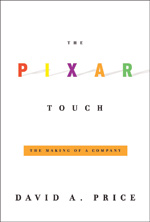(Knopf, 304 pages, $27.95)
By David A. Price
 David A. Price’s well-researched history of Pixar is also a history of the long march of computer-generated imagery from its origins as a gleam in the eyes of several visionary-minded computer geeks to its current ubiquity, and of how Pixar—thanks to the staggering success of movies like Toy Story, A Bug’s Life and The Incredibles—ultimately came to menace even its own most powerful backer, the Disney Company.
David A. Price’s well-researched history of Pixar is also a history of the long march of computer-generated imagery from its origins as a gleam in the eyes of several visionary-minded computer geeks to its current ubiquity, and of how Pixar—thanks to the staggering success of movies like Toy Story, A Bug’s Life and The Incredibles—ultimately came to menace even its own most powerful backer, the Disney Company.
From today’s dizzying heights, Price backtracks to the digital stone age of the early ’70s when the individuals who later formed Pixar were in their prime, giddy on visions of what could be achieved with digital imagery, but with none of the necessary technology yet invented or, in some cases, even conceived.
Oddly, the most interesting part of the book is its first half, devoted mainly to technical exploration—the development of rendering technology, graphics interfaces, contour mapping—a process akin to building an entire new language from the letters of the alphabet on up. Price manages to make the material sing with suspense, much as Tracy Kidder did with The Soul of a New Machine about computers in 1981. But when the story switches to the success of the company after Toy Story, Price finds himself locked into a repeating cycle—creation, data-crunching, marketing, release date, boffo box office—and his story slows down noticeably.
Still, the wars between Disney and Pixar, especially between temperamental polar opposites Steve Jobs and Michael Eisner, provide plenty of diversion. Jobs is both hero and villain of the tale, breathtakingly rude to friend and foe. Oddballs do make history, however, and the events chronicled herein have reached into every corner of modern life, making The Pixar Touch a fascinating road map to the world we all live in now.
Review written by John Patterson.